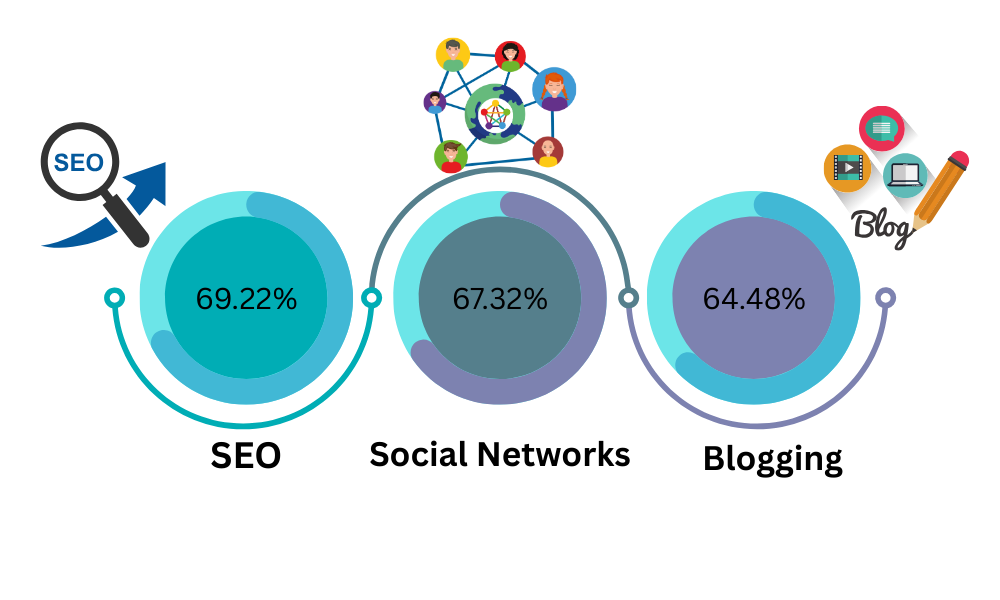Physical Address
304 North Cardinal St.
Dorchester Center, MA 02124
Physical Address
304 North Cardinal St.
Dorchester Center, MA 02124

An affiliate program is a powerful way to grow your business and increase brand visibility.
By partnering with affiliates, you can tap into third-party platforms and reach a wider audience, as they actively promote your products or services on your behalf.
But bringing affiliates on board is just the beginning, you also need to equip them with the right guidance and resources. It’s your responsibility to show them how to market your offers effectively to the right audience.
This is where your content strategy becomes essential. A strong content plan not only helps you attract customers directly but also gives your affiliates ready-to-use material to engage and convert prospects.
When done right, affiliates can drive more sales for your business, boosting your revenue while earning their own commissions, a true win-win.
In the next section, we’ll walk you through how to design a content strategy that maximizes affiliate sales and impact.

Before diving into how to create a content strategy that boosts affiliate sales, let’s first understand what affiliate marketing is.
You might already know the basics, but for those new to it, affiliate marketing is a strategy where you allow others to promote your products or services in exchange for a commission on each sale they generate.
It’s a highly effective way to drive traffic from third-party platforms and grow your revenue. In fact, over 80% of brands worldwide now run affiliate programs, a testament to how powerful this approach can be.
Affiliates can include bloggers, influencers, content creators, online business owners, and many others who have the audience you want to reach.
Content is the driving force behind affiliate marketing. By sharing valuable information, your affiliates spark interest in your brand and highlight the solutions you provide. When paired with the right affiliate marketing tools, these efforts can significantly boost ROI by streamlining and automating campaigns.
The result? Increased brand awareness, stronger online visibility, and a healthier backlink profile. As more relevant external sites link back to your content, search engines receive positive signals, helping you rank higher and attract even more potential customers.
Affiliate marketing makes it easier to reach your target audience and capture more leads through external channels.
For 81% of marketers, content sits at the heart of their business strategy and for good reason. High-quality content is essential for building traction online and engaging your target audience.
It drives brand awareness, strengthens your online presence, and, according to 55% of marketers, plays a key role in boosting search engine rankings. Greater visibility in search results means more organic traffic, helping you attract potential customers without overspending on ads.
Quality content also positions you as an authority in your industry and builds trust with your audience. When you provide valuable answers and insights, people are more likely to trust your recommendations and consider the solutions you offer.
Your content doesn’t just benefit you. It empowers your affiliates, too. By leveraging your resources, they can reach the right audience more effectively, promote your products or services through the best channels, and drive more sales on your behalf.

For example, your affiliates can use your lead magnets to grow their own email lists and promote your solutions through well-crafted affiliate emails.
They can share the guides you create to educate potential customers on how to get the most out of your products or services. Your content can even inspire their own strategies, helping them discover high-traffic topics worth covering.
Testimonials, case studies, and success stories from your website also give affiliates powerful tools to persuade the right people to try your solutions.
One common mistake is assuming affiliates should operate entirely on their own. In reality, success is a joint effort. To get the best results from your affiliate program, you need to work closely with your affiliates, showing them how to reach and engage the right audience.
Many affiliates may be new to entrepreneurship or just starting out in the creator economy, which means they may not yet know how to achieve maximum impact. With your guidance and the content you provide, they can confidently generate high-quality leads that feed directly into your sales funnel.
Now that you understand the vital role content plays in affiliate marketing, let’s explore how to build a high-performing content strategy.
Selecting the right niche is the foundation of a highly targeted content strategy. A niche is a focused segment within your industry that addresses the specific needs of your target audience.
If your business offers a range of products or services, start by identifying what’s in highest demand. By promoting these high-demand offerings through your content, you can maximize results and make the best use of your resources.
This doesn’t mean you should ignore your other solutions. However, the core of your content strategy should spotlight the product or service most likely to attract and convert your audience.
A clear niche focus also helps your affiliates zero in on the most profitable parts of your portfolio, ensuring their content marketing efforts deliver strong results.
Once you’ve defined your niche, the next step is to understand your audience’s interests, preferences, and behaviors.
Knowing your target audience allows you to tailor your message, choose the right tone, and deliver it through the channels they engage with most. This understanding not only boosts engagement but also ensures your content resonates deeply with them.
Different audience segments respond differently to messaging, depending on their personality traits, needs, and motivations. By recognizing these nuances, you can craft content that connects on a personal level.
Your affiliates can also leverage this knowledge, adopting similar tactics to drive traffic and conversions on your behalf.
After researching your target audience, the next step is to develop detailed buyer personas. These personas segment your audience into groups based on demographic and psychographic traits, such as age, interests, goals, and challenges.
Since your audience may span different age ranges and have varying interests, grouping them by shared characteristics allows you to craft a more precise and effective content strategy.
Sharing these personas with your affiliates helps them better understand your customers and engage them more effectively at every stage of the buyer’s journey.
With your buyer personas in place, the next step is to identify keywords that reflect your audience’s needs, interests, or problems.
Given that 68% of online experiences begin with a search engine query, it’s rare for people to visit your website directly. Instead, they search for phrases that describe their challenges or desired solutions.
By creating content around the right keywords, you can greatly enhance your search engine visibility, attract the right audience organically, and strengthen your online presence.
These pillar keywords can also serve as a starting point for your affiliates, enabling them to conduct their own research and create relevant, impactful content that aligns with your brand.
There are many content formats to choose from when engaging your audience, whether text-based or visual, long-form or short-form. The key is to identify which formats deliver the best results for your brand.
Look to your competitors for inspiration by analyzing the types of content they use to engage their audiences. However, remember that there’s no one-size-fits-all approach. You may need to experiment with different formats to find what resonates most with your audience.
These insights can also guide your affiliates, helping them create content that generates maximum engagement and conversions.
Low-hanging opportunities are content ideas that can quickly drive traffic and engagement with minimal effort.
While building authority and achieving consistent results through content is a long-term process, these opportunities allow you to see faster wins. They often include trending topics or market gaps that address your audience’s immediate needs.
By covering such timely topics, you can spark quick interest and attract more visitors in a shorter time frame. Your affiliates can also leverage these opportunities, amplifying their reach and creating buzz around your brand more effectively.
Never compromise on the quality of your content. A common mistake businesses make is focusing so much on maintaining a consistent publishing schedule that quality takes a back seat.
While frequency and consistency matter, they should never come at the expense of delivering real value. Your content should answer your audience’s questions, solve their problems, and provide actionable insights they can trust.
By consistently offering high-value information, you not only strengthen your online presence but also position yourself as a thought leader in your industry.
The same principle applies to your affiliates. Providing them with clear content quality guidelines ensures they can drive relevant traffic to your site while building credibility on their own platforms.
When buying from an unfamiliar brand, people often look for reviews and recommendations. They want to hear about the experiences of others before making a decision which is why user-generated content (UGC) can be a powerful tool for boosting traction and conversions.
Customers share feedback directly with you or post about their experiences on social media. This content is valuable because it showcases real stories from real customers, helping you build trust and persuade prospects to try your solutions.
When crafting your content strategy, make sure to include customer reviews, testimonials, and other UGC. Publish them on your website, share them in relevant online communities, and encourage conversations around them.
Your affiliates can also use UGC as social proof, reinforcing your brand’s credibility and reliability in their own promotions.
Quality content alone isn’t enough, it needs to reach your audience. As part of your content strategy, identify the platforms where you’ll promote your material.
Social media is one of the most effective channels for widening your reach, allowing you to connect with millions of users worldwide. Focus on the platforms your audience prefers and share your content there consistently.
Affiliates can also use these same channels to connect with similar audiences, extending your brand’s reach even further.
To maximize results, regularly track your content’s performance and look for areas to improve.
Even with careful planning, outcomes may differ from expectations. Audience needs, preferences, and industry trends also evolve over time making continuous evaluation essential.
Be ready to adjust your strategy, optimize underperforming content, and pivot when necessary. Encourage affiliates to do the same so their efforts stay aligned with audience demands and keep driving sales for your brand.
To maximize ROI from your affiliate program, collaboration is key. Working closely with your affiliates not only helps them generate more traction for your brand but also makes it easier for you to drive consistent sales.
This partnership creates a win-win scenario, your revenue grows exponentially, and your affiliates earn higher commissions.
At the heart of this success is a strong content strategy. It’s the foundation that allows you and your affiliates to connect with the right audience, build trust, and ultimately achieve more conversions.